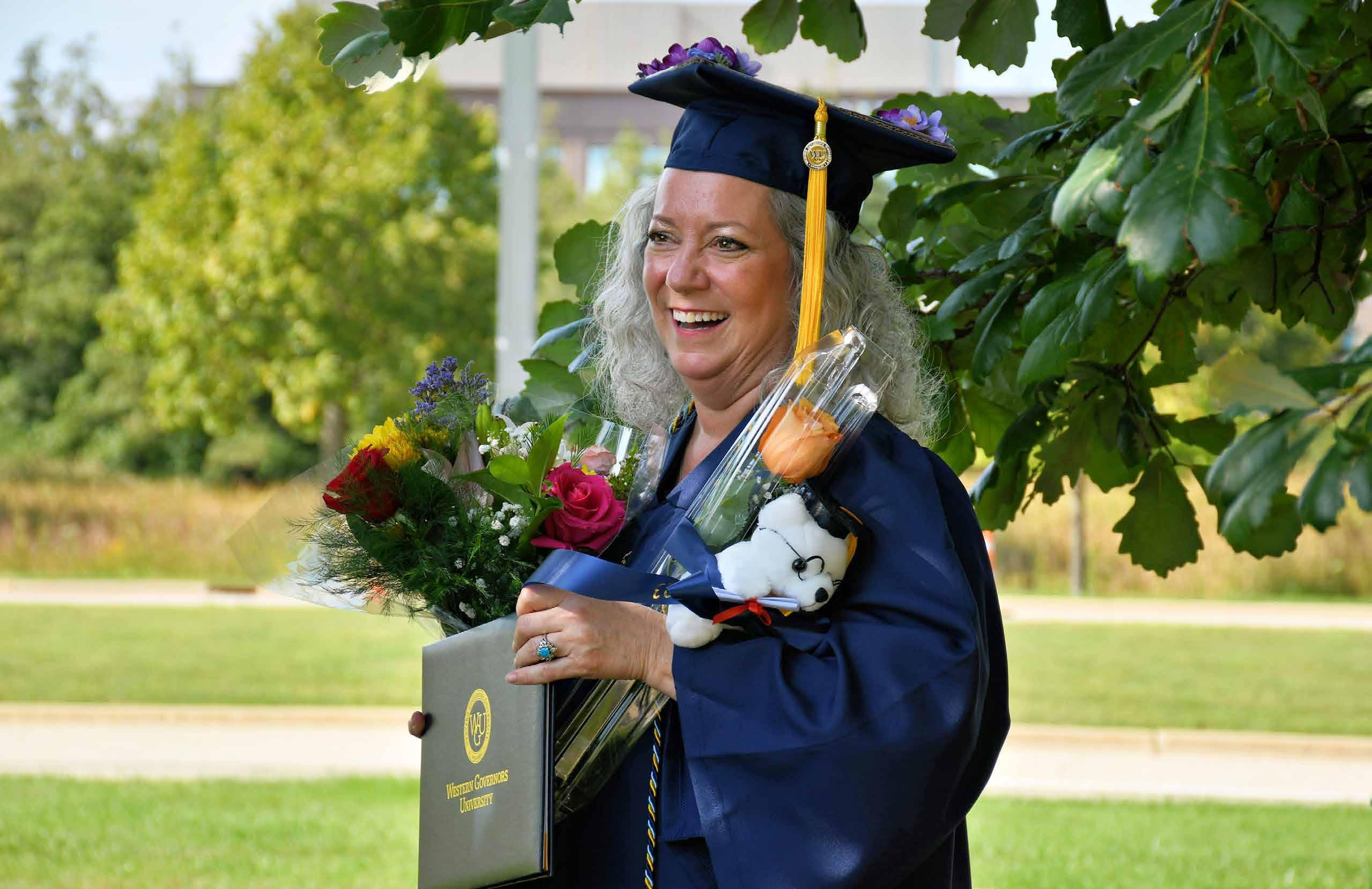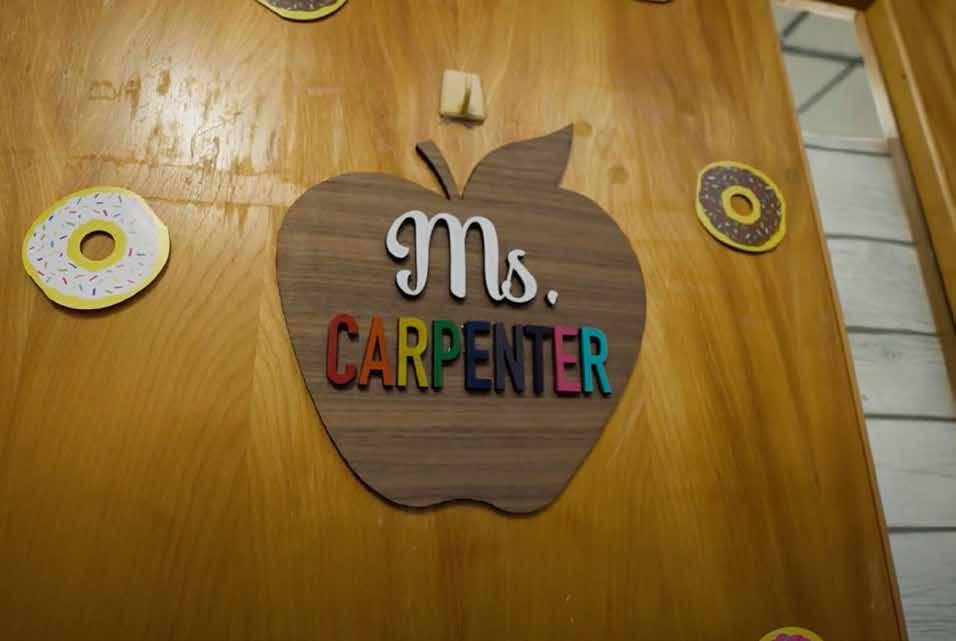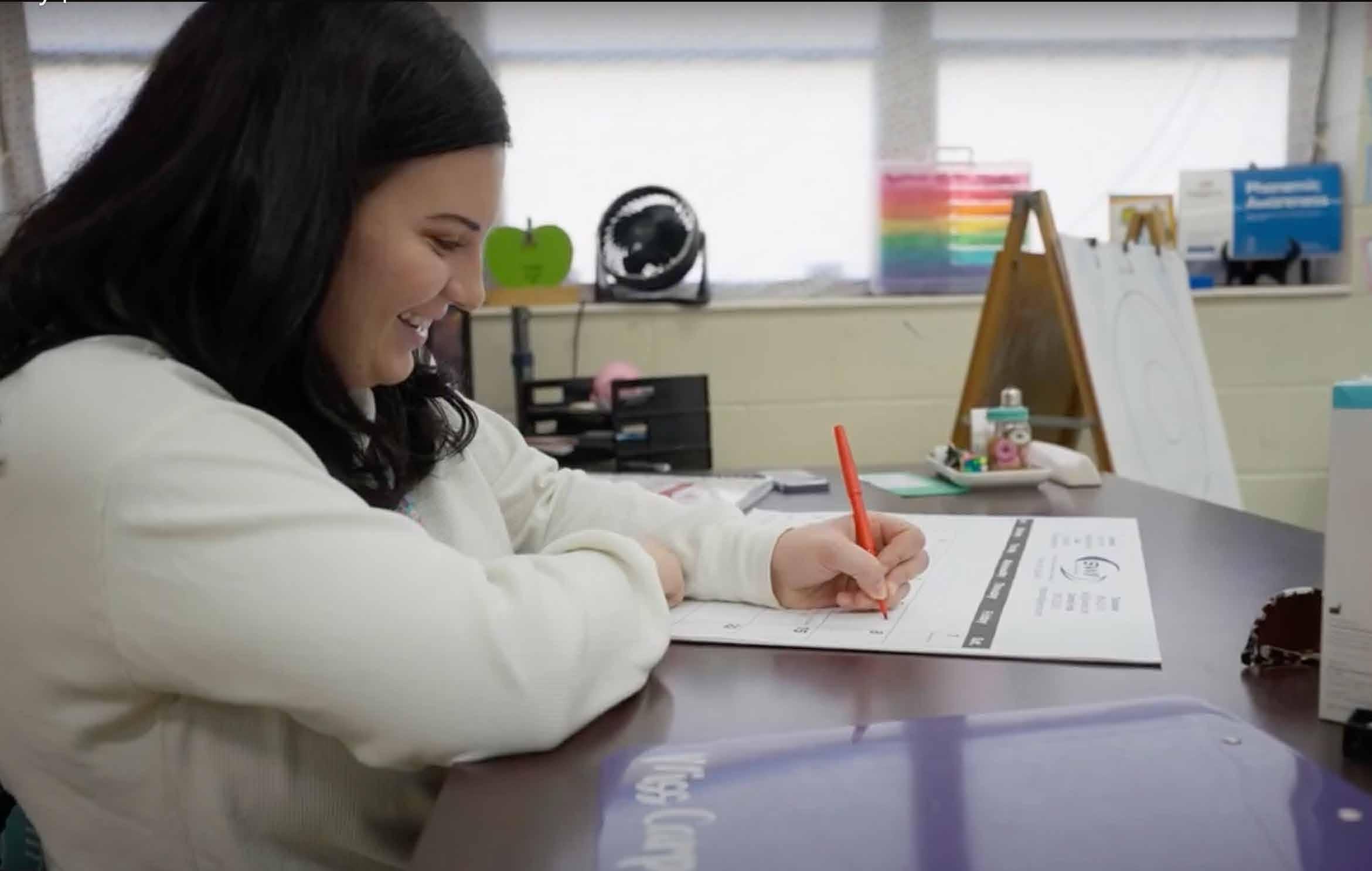THE STATE OF WGU



Dear Policymaker,




Dear Policymaker,
The stories encapsulated within these pages serve as vivid illustrations of the real-world impact resulting from the decisions made in your influential role. These decisions empower individuals to pursue their dreams, contribute significantly to their communities, and elevate key sectors within the workforce.
As a policymaker, your role is nothing short of transformative. You play a pivotal part in shaping the future of education and workforce development. Your commitment is vital to fostering accessible, quality education that propels the workforce forward. This dedication, I believe, is not only essential but also the cornerstone of building a vibrant and prosperous economy. Your influence extends beyond legislative halls—it reaches into the hearts and minds of individuals striving for a better future.
In every decision you make, remember that you are steering the course toward a more
inclusive, innovative, and accessible educational landscape. Your dedication to education is an investment in the future, and your support resonates with individuals like Kayla, Obi, and Joy, whose stories are testaments to the impact of Western Governors University.
Thank you for championing the cause of education. We recognize that your support fuels our collective mission to transform lives through learning. As we continue this journey together, your ongoing dedication will play an instrumental role in shaping a future where education is a force for lasting positive change.
With gratitude and respect,

Terrance Hopson, Ed.D. Regional Vice President Midwest Region



I am delighted to welcome you as we unveil the inaugural edition of The State of WGU, a magazine from Western Governors University. As the Vice President of External Affairs, it is my distinct pleasure to introduce this publication, which will offer insights into the transformative impact of our institution and the pivotal role it plays in shaping the future of higher education.
WGU is rooted in the belief that access to highquality education should be within reach for all individuals, regardless of their circumstances. In these pages, I invite you to meet Kayla, Obi, and Joy, three remarkable WGU graduates whose journeys epitomize the profound impact that online, competency-based learning can have on individuals and their communities.
This first edition of The State of WGU not only introduces you to the stories of individual learners but also looks at the bigger picture of higher education. We provide a comprehensive overview of what competencybased education is, how it functions, and the myriad benefits it brings to learners, employers, and states alike. As innovators in the world of education, we believe in equipping our graduates with skills and knowledge that align seamlessly with the needs of today’s workforce.
Furthermore, we recognize the critical importance of addressing workforce shortages in key sectors, particularly nursing and teaching. In these pages, you will discover how WGU is actively contributing to solutions for these shortages. We are working in tandem with policymakers to bridge the gaps in critical professions, ensuring that our graduates are ready to make meaningful contributions from day one.
As we reflect on the accomplishments of 2023, this magazine serves as a testament to the strides we have made in partnership with states such as Nebraska, Montana, and Ohio. Collaborating closely with these states, we have embarked on initiatives to make higher education more accessible and affordable. We understand that by aligning our efforts with state priorities, we can collectively address workforce challenges and elevate the prospects of citizens across the nation.
In closing, I extend my gratitude for your ongoing support and advocacy for higher education. I believe that by working together, we can continue to shape the future of learning and create opportunities that empower individuals and strengthen our communities.
Thank you for joining us on this journey. I hope you find The State of WGU both informative and inspiring as we collectively chart the course toward a brighter, more accessible future for higher education.
Sincerely,

Chris Bonnell Vice President of External Affairs

Check it out!
For an even deeper look into the evolving world of higher education, tune in to the Sage Advice Podcast. In each episode, we bring together thought leaders, policymakers, and educators to discuss our unique approach to learning that prioritizes student success, affordability, and real-world skills.
Make sure to tune in to Sage Advice on Apple Podcasts, Google Podcasts, Spotify, or anywhere podcasts are found. Follow so that you don’t miss any future episodes.




What began as an idea shared by 19 governors has evolved into the largest university in the nation.
In 1995, just as traffic started picking up on the information superhighway known as the World Wide Web, a meeting of the Western Governors’ Association convened in Utah. Among the topics up for discussion was postsecondary education.
Members of the Association shared their concerns about the rising cost and underwhelming performance of higher education in their states. These governors feared that their states lacked the collegeeducated workforce needed to fill open positions, and they needed to create an alternative.
Simply put, higher education took too long, cost too much, and didn’t ultimately deliver clear results.
“We wanted to change the face of higher education,” said then-governor of Wyoming Jim Geringer.
And so, they did.
A taskforce of 19 governors was formed to address the issue of higher education. At the same time these conversations were happening, a revolutionary new technology was emerging. The internet could provide a means to deliver education online to the maximum number of people.
This approach wasn’t just new–it was revolutionary. With soaring tuition prices, the governors came up with a plan to offer a flat-rate, term-based tuition, meaning students could take and pass as many classes as they’d like for the same low price. Instead of spending weeks in a classroom, students could pass their courses as soon as they mastered the material through a concept called competency-based education. To top it all off, an online-only learning model could help more people access education and cut down on facility costs.
But getting a university off the ground wasn’t as simple as signing a paper. There was funding to be secured, students to recruit, and curricula to design. No one person could design a whole university, so how much could this one task force do?
Turns out, 19 dedicated governors can accomplish a great deal. Word of this soon-to-be university spread like wildfire; Scott McNealy, co-founder of Sun Microsystems, heard about the governors’ efforts and wrote a check for $500,000. IBM, Microsoft, and Cisco all became early contributors. They believed in the governors’ vision for a new approach to higher learning.
In 1997, Western Governors University was born.
“
We wanted to change the face of higher education.
JIM
GERINGER FORMER GOVERNOR OF WYOMING

By harnessing the power of the internet and following a competency-based education model, WGU revolutionized the way students learn. For the first time, higher education was no longer restricted by time and place; instead, WGU created an educational model that meets students where they are and when they are available.
Since its founding, WGU has transformed the landscape of higher education. Here are the numbers to prove it.
97%
Percent of employers saying they would hire another WGU graduate*
4
WGU schools offering programs in high-demand careers: Information Technology, Business, Healthcare, and Education
Within

33
The median age of a WGU student
169,379
Total WGU enrollment as of December 2023
The number of American adults with some college education but no degree**
40,100,000 $8,010
The average WGU tuition for one year
Number of WGU degrees awarded to date
357,074 $800,000
The average lifetime earnings increase for a WGU graduate with a bachelor’s degree
While WGU’s history may be relatively short when compared with the timeline of higher education,it has reshaped the way we as a nation learn. WGU was born from the innovative spirit of 19 governors who strove to do the best they could for their respective states. Now, WGU continues the legacy of those first 19 by innovating with states—and most importantly, with students—in mind.
*https://www.wgu.edu/content/dam/wgu-65-assets/web-sites/about/images/annual-report/2023-annual-report/Harris-Poll-Employers.pdf **https://nscresearchcenter.org/some-college-no-credential

With an innovative competency-based education model, WGU paves the way for groundbreaking achievements in education, careers, and beyond.

Competency-based education really helps an individual, particularly those that are working learners, move at the pace that’s right for them.
WGU PRESIDENT SCOTT PULSIPHER “
“I have faced challenges such as breaking gender barriers in the tech industry and overcoming self-doubt,” says Obianuju (Obi) Akusoba. “Through determination and support from mentors and the WGU community, I have been able to overcome these challenges.”
Obi’s story is inspiring, but it is not unique at WGU. Obi had built a successful career as an IT support technician with her GED. After being promoted three times in as many years, however, Obi realized that to advance further, she would need to pursue some form of higher education. But spending hours a week in a brick-and-mortar school
wasn’t an option for Obi. She, like so many others, could not afford to sacrifice her employment for her educational aspirations.
Despite her reservations, she gave online learning a chance and enrolled in a software development bachelor’s degree program at WGU.
“Learning that I could keep my job and still go to school was really empowering,” Obi said. “As soon as I got settled in my role as a student, all of my worries went away.”




The traditional model of higher education, which requires students to dedicate extensive hours to classwork over several years, has grown increasingly unattainable for students like Obi. That’s why WGU has embraced the innovative approach of competency-based education, which allows learners to progress through their coursework based on their mastery of the subject matter rather than adhering to a rigid time-based structure.
“Competency-based education really helps an individual, particularly those that are working learners, move at the pace that’s right for them,” said WGU President Scott Pulsipher. “Particularly for working learners who have already gained knowledge and skills through previous experiences, competency-based education allows students to accelerate through those things that they know so they can focus on areas in which they need greater proficiency.”
Under WGU’s model, students can earn their degree and go straight into the workforce rather than sitting for weeks in a traditional course environment. By applying the knowledge and experiences she had gained while working in the field, Obi breezed through introductory IT courses and quickly moved on to more advanced subject matter that would enable her to pivot her career toward software development.
“I was able to knock out a lot more classes than I would probably have done if I were brand new,” she said.

She is limitless in her possibilities and what she’s been able to create.
SCHLAINE HUTCHINS
OBI’S
PERSONAL MENTOR

Education isn’t just about what you learn or how you learn it; equally important are the relationships you form along the way. Contrary to popular belief about online universities, WGU Night Owls are more than just numbers on a screen. WGU emphasizes the importance of community building, assigning a mentor to each student and encouraging participation in student organizations.
“Having someone in your corner can make all of the difference for students as they navigate life’s twists and turns and juggle responsibilities on top of their course loads,” President Pulsipher said. “We know the inherent worth of every individual, and we are focused on changing their lives for the better, one student at a time.”
During her time at WGU, Obi connected with her fellow students as the very first president of the WGU Women in Tech Club.
“I saw it as an opportunity to connect with other students, learn from them, build a bond, even grow a community of other like-minded people, women, and also other folks who identify as allies for women in technology,” she said.
Obi was instrumental in Women in Tech’s growth from fewer than 70 participants in 2019 to more than 10,000 women and allies who are either pursuing or have completed their IT degrees through WGU. Over 10,000 individuals are now prepared to pursue careers in some of the most high-demand fields across the country.
“They’re now encouraging each other not only in the pursuit of their degree, but also in the attainment of the jobs and opportunities they’re wanting to pursue,” President Pulsipher said. “It’s incredibly inspiring to see.” WGU
We know the inherent worth of every individual, and we are focused on changing their lives for the better, one student at a time.
PRESIDENT SCOTT PULSIPHER




to see.”
Like so many WGU Night Owls, Obi has gone on to defy the stereotypes—and then some.
Today, Obi is a software developer at a Fortune 10 data analytics company. She is pursuing a master’s degree at one of the preeminent programs in her field, and in November 2023, Obi was honored with a Distinguished Graduate Award at a networking event for WGU’s School of Information Technology.
In front of a crowd of her peers and industry professionals, Obi was presented the award by her personal mentor, Schlaine Hutchins, head of IT and Governance at Mettler-Toledo International, Inc.
“I’m thrilled tonight to be celebrating Obi, because she has changed me and made me take a look at myself and do more,” Hutchins said. “She is phenomenal. She’s a young woman with a lot of talent, skill, passion, and compassion for others. She is limitless in her possibilities and what she’s been able to create.”
Obi is living proof that there is no such thing as “just” an online degree. Her education has given her the chance to prove her passion, resilience, talent, strength, and grit.
“I’ve been able to break all the ceilings,” Obi said. “I’ve been accepted at Ivy League colleges. Everything they said you couldn’t do with an online degree, I have done. That’s something I’m very proud of.”
Through competency-based education, WGU empowers working learners to pursue a high-quality education at a fraction of the cost and time of traditional institutions.
Learn more about Obi by watching her story here:

Roy Romer owned and operated a flight school before serving as governor of Colorado from 1987 to 1999. What mattered to Romer was a student’s ability to operate a plane safely; no set number of hours in a cockpit guaranteed a student’s success in the air.
Romer understood that a pilot who is skilled in flying a plane doesn’t need to be taught again. Other students, however, need more practice to become competent in certain flight skills.
As governor, Romer was among the founders of WGU. His experience on the airfield led WGU to adopt a cutting-edge competency-based education model, in which students pass courses based on their mastery of a subject rather than how long they’ve attended a class.
Most U.S. colleges and universities use time as a measure of educational attainment. The Carnegie Unit model, designed over a century ago in 1906, is the genesis of the traditional academic calendar in higher education. Students must attend a certain number of hours of instruction to move forward in their academic journeys.
But what if a student knows the material? What if they need more time on a particular topic?
WGU tailors the pace to each student individually. Many students begin their WGU journey with some college and work experience already. Through competency-based education, students can apply what they
know to their studies and move through the material at a pace that works best for them.
“The self-paced classes are what have made things go so quickly, along with my amazing mentor. There is so much support, it’s near impossible to not succeed at WGU,” said WGU graduate Misty Shields.
No two people learn the same way and at the same time. While cognitive and educational science has advanced by leaps and bounds, the component of time remains rigid in most schools.
WGU programs have been lauded for rigor and innovation. Our assessments are designed to reflect the skills and abilities students need to be successful, and our curricula are as challenging as those of any traditional institution. The difference is that WGU students can take an assessment when they are ready, not after a specific number of hours of instruction.
At WGU, we empower students to pace themselves.
Students work with their mentors and instructors one-on-one to develop a

learning schedule. These expectations are designed around the demands in their individual lives, which often include caregiving responsibilities and full-time jobs. We never expect our students to fit a specific mold.
“If I already knew the subject matter in the class, either from prior education or personal experience, I wasn’t required to stay in the class just for the sake of fulfilling a time requirement” said WGU graduate Denise Watkins.

Through competency-based education, students can speed up and slow down based on their experience with the material. Students already well-versed in a subject can accelerate toward completion without sacrificing quality. All students in a program take similar assessments, but all students take different amounts of time.
With no set class times, students can complete coursework and assessments when the time suits them—meaning that students can test during early and late hours, focusing on academics after their child’s bedtime or before they go to work. Competency-based education is a gift to many working learners, who say they wouldn’t have been able to complete their degrees without WGU’s flexible model.
“I had tried to advance my career for years and was never able to make progress as a working adult with children and a busy life. I was able to get my bachelor’s degree within 12 months. The job market has opened up to me, and I will soon be able to use my talents and be challenged at work, all while earning a decent living,” said WGU graduate Kirsten.
The competency-based model has been foundational to our students’ success. Thanks to former governor Roy Romer, WGU’s students are in the pilot’s seat of their education—and their lives.



A Nurse’s Path to an MBA

The pathway to professional excellence in healthcare is complex. A provider needs passion and a relentless pursuit of knowledge to succeed. The same can be said of those who run businesses. Learning the ins and outs of the business world requires dedication and practice.
Business and healthcare are two demanding fields that may seem unrelated, but they often work hand in hand. From running small-town clinics to massive city hospital systems, healthcare operations need business know-how. A hospital cannot function if it can’t afford to pay its employees or if its financial resources are depleted after purchasing expensive equipment.
Healthcare professionals may feel misunderstood by their business-minded colleagues. The reverse is often true as well. Business professionals may feel frustrated by a healthcare worker’s lack of financial knowledge. Yet the convergence of these two paths is inevitable and vital. Healthcare must be delivered effectively and matched with business strategies encompassing compassion while financially stabilizing the institution.
Education can equip future leaders with a dual lens, allowing them to see through the pragmatic clarity of business while maintaining the empathetic vision of healthcare.
However, balancing the need for business acumen in a healthcare setting is a challenge. Becoming fully educated in two different fields is an intensive undertaking, yet it is possible.
Nursing has given me so much. I don’t know what I would be if I weren’t a nurse. “
JOY L. KING
Meet Joy L. King, a distinguished healthcare and business administration professional. Joy is a family nurse practitioner, an adjunct professor of nursing at Georgia College, and the president-elect for the Georgia Nurses Association Board of Directors.
And she is a proud WGU Night Owl.
Like many healthcare professionals, Joy’s path to nursing began with personal adversity. Joy lost her father after two debilitating strokes when she was just ten years old.
“That was the first time I was acquainted with healthcare,” Joy said.
During her father’s illness, Joy remembers the time the nurses spent with him, and their dedication and compassion left a profound mark. It was then that she knew what she wanted to do for the rest of her life. Joy found solace in the prospect of alleviating others’ suffering—a calling she wholeheartedly embraced. And so, she pursued a career in nursing.
“If I can make someone feel the compassion and care my dad received, I would love to do that,” Joy said. “This might be my place in the sun. This might be my calling.”


Joy remains committed to her rural Georgia roots. While she stays partly due to familial ties, she also knows that by staying, she can ease the disparity in healthcare access between rural communities and metropolitan areas. The need to access high-quality healthcare in rural communities is more critical than ever—and Joy knew she could help.
“I don’t want to go to these larger cities because I’m needed here. These are my people,” Joy said.
But staying in a small community also meant that Joy needed to do more to become the nurse her loved ones needed. Working as a nurse, she saw the need for healthcare workers to have solid business acumen. While she could expertly care for her patients, there was one set of questions often asked of her that she didn’t know the answer to: why does it cost this? As she skilled up and became a more experienced nurse, Joy began to wonder how she could continue to rise in healthcare.
“Nursing school doesn’t teach you business,” Joy said. “What happens if you want to climb the ladder? How do you do that if you don’t understand the business side?”
As she began to increase her understanding of the business side of healthcare, she saw the opposite was true for her new colleagues who had never worked a nursing shift. They didn’t know the ins and outs of what nursing entails.



Joy saw the need for a holistic understanding of healthcare, the understanding of practical application paired with the knowledge of how the clinic and hospital business function. She knew the next step was an MBA, but she knew only some schools would meet her needs.
“I’d been cohort-ed to death. I wanted to do something at my own pace,” Joy said. “I just wanted something flexible.”
Joy needed a pathway that could empower her to keep working as a nurse practitioner. After all, her patients’ health concerns wouldn’t simply vanish if she took time off to pursue a degree. But without an MBA, Joy was stuck—she wouldn’t have the knowledge and credentials to hold her own when it came to advocating for nurses.
When Joy first heard that WGU had a Master of Business Administration in Healthcare Management program, she knew where she wanted to go. With the flexibility offered by WGU’s online courses and revolutionary competency-based education, Joy could continue caring for her patients while deepening her business knowledge. Now, she is the only faculty member at Georgia College’s nursing school with an MBA.

“
It’s so important to be involved [in advocacy] because it puts you in a position where you’re a voice for the nurses in the state.
JOY L. KING
WGU ALUM





As her education credentials grew, Joy found more opportunities to make a lasting difference in the lives of both nurses and patients. With her experience as a nurse lending firsthand knowledge and real-time data collection, Joy found herself rising in healthcare as well as in advocacy.
“It’s so important to be involved because it puts you in a position where you’re a voice for the nurses in the state,” she said.
Joy has taken her extensive education and turned herself into a beacon of hope for her patients and her fellow healthcare practitioners. She fervently believes in the power of nurse-led initiatives, championing causes that prioritize patient welfare and nursing autonomy—causes like the Safe Staffing Bill in Georgia, which aims to make a systemic change in nurse-to-patient ratios.
“[The bill] started with someone voicing a concern to the Georgia Nurses Association,” Joy said.
As a nurse, advocate, and businessperson, Joy continues to serve her community of nurses. She hears and understands the issues nurses face and can balance those issues with her knowledge of the financial side of healthcare. She remains at the heart of change, empowering nurses while remaining faithful to her original calling.
“Nursing has given me so much. I don’t know what I would be if I weren’t a nurse,” Joy said.
Even before COVID-19, statisticians predicted that there would not be enough trained nurses to meet demand. This has been exacerbated by the pandemic, causing a nursing shortage close to 13 million workers across the world.1 In the United States, about 1.1 million nurses need to be replaced by 2024.2
Factors that impact the current staffing shortage among nurses include an aging population, aging workforce, nurse burnout, wage disparities, family obligations, lack of nursing faculty,3 and infection rates and death.4
However, a significant factor contributing to the shortage is limited access to nursing education and training. Even though student applications surged in fall 2020 programs, there were 80,521 qualified applicants who could not be admitted due to a shortage of teaching faculty.5 For 40% of schools, the sole reason for not accepting all qualified applicants was the insufficient availability of clinical sites.6
Nurses with a baccalaureate degree have better skills in critical thinking, leadership, communication, and problem solving, and they also produce better patient outcomes and
lower mortality rates.7 However, only 64.2% of registered nurses have a baccalaureate or graduate-level degree; the Institute of Medicine Committee recommends increasing baccalaureate-prepared nurses to 80%.8
States like California are experiencing an urgent need for nurses with baccalaureate degrees to maintain a robust medical system that meets current population demands. For example, California has three times the deficit of the next shortest state for registered nurses.9 About 70% of nurses in California had at least an associate degree, but only 16% of those nurses returned for their bachelor’s.10 States with the most severe shortages include California, New Jersey, South Carolina, Alaska, Texas, and Florida.
Areas with high retirement populations are greatly impacted by the shortage,11 and special attention should be considered in healthcare deserts,12 where nearly 80% of rural communities are medically underserved.13 Students who train in rural areas are more likely to stay there.14



Policymakers on the state and federal levels can combat the nationwide nursing shortage by increasing access to competency-based nursing education. The prioritization and investment in education would offset current healthcare costs, which is approximately 18% of the U.S. GDP.15
The following are specific policy recommendations that would address the nursing shortage.
• Policymakers can advocate for more synergy between the Department of Education and state federal reimbursement for nursing boards to decrease licensure barriers for nurses nationwide.
• Investing in programs that help nurses with associate degrees obtain bachelor’s degrees can boost the career trajectories of those ready to advance their degree.16
• Licensure reciprocity would allow healthcare workers to move their licenses across state lines as long as they are in good standing in their home state. The boldest example of licensure reform is in Arizona, which adopted universal licensure to permit licensed individuals relocating from other states to practice within Arizona if they meet certain safeguards (e.g., practicing at least a year, in good standing in their original state of license).17
• In January 2014, the University of Wisconsin (UW) announced the $3.2 million Nurses for Wisconsin initiative to provide fellowships and loan forgiveness for future nurse faculty who agree to teach in the state after graduation.
• NY S.8175A: Enacts the RESPECT Nurses Act to “recruit, empower, support, pay, educate, connect and train” current nurses and nursing students, thereby increasing the number of nurses within the state of New York.18
• H.B.2221: Appropriates funds to support Hawaii's nursing workforce and address the nursing workforce shortage by increasing University of Hawaii nursing faculty positions, providing education grants to qualified students who represent underrepresented persons in nursing, and providing greater training and development for nurses.19
• The Center for Health Outcomes and Policy Research at University of Pennsylvania calls for adapting federal funding mechanisms (i.e., Title VIII and Medicare) to focus on preparing more nurses at the baccalaureate and higher degree levels. This policy emphasis is needed to adequately address the growing need for faculty and nurses to serve in primary care and other advanced practice roles.20
Improving access to nursing education is vital to the nation’s health and economy. WGU’s Leavitt School of Health is specifically designed to help working learners pursue their nursing degree on their own schedule. WGU’s rigorous nursing programs are supported by instructors and mentors who equip students with the academic and professional skills they need to succeed in their career.

Read more about the national nursing shortage and access the full reference list by scanning the QR code.
Nurses are the lifeblood of healthcare systems. By designing policies that enable nurses to thrive, we create the building blocks for a healthier world.
That is the vision Dr. Kimberly Kelly-Cortez, Senior Associate Dean and Director of Academic Programs at the Leavitt School of Health, brings to life in a recent episode of the Sage Advice podcast. Dr. Kelly-Cortez, a pioneer in nursing education, has played a pivotal role in expanding enrollment and revolutionizing training at WGU. In her conversation with Emma Salomon, Digital Advocacy Director at WGU, Dr. Kelly-Cortez shared valuable insights into how forward-thinking policy changes can transform the future of nursing education.
Dr. Kelly-Cortez’s career began in front of a high school history classroom, not in a hospital wing. As she climbed the educational ladder from teacher to assistant principal, she witnessed firsthand the social disparities that extended beyond school walls. Many of her students, aspiring to heal and help in the healthcare sector, found their paths obstructed by the very system they hoped to join. This irony was not lost on Dr. Kelly-Cortez, who saw an opportunity to bridge the gap.
But Dr. Kelly-Cortez’s journey to her doctorate in nursing science was not without hurdles. As an adult returning to academia, she faced the daunting challenge of balancing financial constraints with pursuing higher education.
The rigidity of nursing programs often clashes with the realities of adult life; maintaining employment while enrolled is often non-optional. Many adult students struggle to justify the time and financial commitments required to enter the field with the demands of their personal lives. Dr. Kelly-Cortez emphasizes the need for programs that accommodate working adults, accelerate learning, and enable nurses to remain in their home communities.
“WGU’s approach to nursing education emphasizes accessibility and relevance in diverse communities,” Dr. Kelly-Cortez said, advocating for a system that empowers nurses to serve their communities more effectively. And, having been an adult returning to school, Dr. Kelly-Cortez knows just how important the flexibility WGU offers is.
“I would have loved to have had WGU as an option for me on my journey,” Dr. Kelly-Cortez said. “Back then, there were not a lot of opportunities for you except to quit your job and go back to school full-time.”



Dr. Kelly-Cortez calls for policy interventions that offer more than just temporary fixes to our nation’s ongoing nursing shortage. She advocates for financial incentives for nursing educators, streamlined clinical placements, and systemic changes in healthcare education. It’s a crucial strategy for the overall well-being of entire states.
“There have to be other ways that we subsidize and help,” Dr. Kelly-Cortez said, stressing the need for policies that address the root of the crisis.
The stakes are incredibly high. The COVID-19 pandemic has ruthlessly exposed the nursing shortage, a crisis that Dr. Kelly-Cortez confronts with urgency.
“We lost a lot of veteran nurses...the average age of the nurse at the bedside dropped considerably after the pandemic,” she revealed.
This loss extends beyond healthcare facilities; it’s a seismic shift that ripples through the entire fabric of state healthcare systems. The nursing shortage, if left unaddressed, could cripple the backbone of our healthcare system.
It’s not just a healthcare crisis; it’s a nationwide emergency calling for immediate and effective action.
A depleted nursing workforce means longer wait times for medical care, reduced patient-nurse interaction, and compromised patient care quality. In rural areas, the situation is often more dire. The loss of seasoned nurses puts additional pressure on already strained rural healthcare systems. These communities commonly face the brunt of healthcare disparities. Aspiring nurses in these areas traditionally had to leave their communities to pursue education, further depleting local healthcare resources.
WGU offers a solution. By providing flexible, community-integrated clinical classes, WGU allows aspiring nurses to stay and serve in their communities. This educational approach doesn’t just benefit individual nurses or their immediate patients; it’s a lifeline for entire communities. It stabilizes local healthcare systems, ensures continuous and quality care for residents, and strengthens the overall health resilience of the state.
Looking ahead, Dr. Kelly-Cortez is optimistic about the role of WGU in revolutionizing nursing education. With plans to expand into more states and communities, WGU aims to make a significant impact on the nursing shortage.
“We’re hoping we really can impact this on a much greater scale,” Kelly-Cortez said.
Dr. Kelly-Cortez sees a future where nursing education is a catalyst for change, rather than a response to crises. Her recommendations to nurture a resilient and competent nursing workforce and to support institutions like WGU with state funding can turn the shortage around, strengthen at-risk communities, and empower populations. By supporting innovative programs like WGU’s, you’re not just investing in nursing education–you’re fortifying the foundation of our healthcare system.

To hear Dr. Kimberly Kelly-Cortez’s full conversation with Emma Salomon, listen to the Sage Advice podcast— available on Spotify, Apple Podcasts, and wgu.edu/inyourstate.
WGU’s approach to nursing education emphasizes accessibility and relevance in diverse communities. “
KIMBERLY KELLY-CORTEZ, PHD
SENIOR ASSOCIATE DEAN AND DIRECTOR OF ACADEMIC PROGRAMS


Thanks to its online, competency-based model, WGU helps rural students stay and thrive in their hometowns, empowering them to build and maintain a more robust workforce right where they live.
In Montana, halfway between Butte and Helena, there is a little town called Boulder. Not to be confused with its more populous namesake in Colorado, the Boulder in Montana boasts panoramic mountain views and a population of roughly 1,200.
It’s the perfect home for someone with a lifelong passion for animals and outdoorsmanship—someone like Kayla Hecht Bare.




“I live here because I really love the outdoors,” Kayla said. “Especially when it’s a crystal clear blue day with no clouds or anything…it feels like the state expands into no-man’s-land and there’s mountains everywhere you go. We can experience the wilderness right here in our backyard.”
To some, the thought of leaving such idyllic surroundings seems inconceivable, but for young people seeking to advance their careers through higher education, it can feel like the only option.
“They often say that the number one export in Montana is not our water and it’s not our minerals. It’s our kids,” said Sarah Swanson, Commissioner of the Montana Department of Labor & Industry.
“To pursue the opportunities young people are interested in today, they leave the state to go to university or to go for an internship or a residency. And the return rate of our young people when they leave is not as high as we’d like it to be.”
On September 25, 2023, Commissioner Swanson joined Montana Governor Greg Gianforte, along with representatives from the Montana Hospital Association, Montana Chamber of Commerce, and Western Governors University, for a roundtable discussion addressing this exodus of students from rural communities and its impact on the state’s workforce.
“We know that every year from now until 2032, we need at least 20,000, arguably 21,000, new skilled workers in careers like teaching,” Commissioner Swanson said. “That doesn’t include our urban counties, that is just 20,000 Montanans a year in our rural communities that we’re not adequately prepared for.”
Solving Montana’s workforce needs is a strategic challenge that requires complex solutions–and it starts with making higher education more accessible to students right in their rural hometowns.
“Our obligation through our education policy and partnerships is to help every student reach their full potential,” said Gov. Gianforte. “This is where WGU comes in.”
Our obligation through our education policy and partnerships is to help every student reach their full potential. This is where WGU comes in.
MONTANA GOV. GREG GIANFORTE


Teaching runs in the family for Kayla. Her mother, Kayla’s greatest role model, has worked in education for Kayla’s entire life. While sorting through boxes of childhood mementos, Kayla found a project she had completed in kindergarten. Right there, following the question, “What do you want to be when you grow up?”, was a single word in a six-year-old’s scrawl: teacher.
So when she decided it was time to change from the physical therapy career she was pursuing, Kayla knew what direction she wanted to take–she just didn’t know where to turn.
“I had really wanted to just give up from my last school that I was at. I didn’t feel like I was getting accepted and supported,” she said. “I just kind of wanted to do what my brother did: work for a year and then eventually find a school that would work for my lifestyle…being able to work a full-time job [and] provide for my family.”
That’s when her mother told her about an online university a family friend had attended: somewhere she could work at her own pace, from her own home, and receive a teaching degree in a fraction of the time (and at a fraction of the cost) of a traditional university.
From the moment she enrolled, Kayla knew that WGU would be different.
“When I realized what kind of a community WGU was, I was glad I made the change,” Kayla said. “They helped me see that I didn’t have to give up [my own community].”
WGU’s School of Education is the largest in the nation, with more than 37,000 active students across the United States. Kayla’s instructors and mentors at WGU continued to care for her throughout the course of her education, even helping her find a student teaching placement right in Boulder.
“They boosted me up and they batted for me,” Kayla said. “It really made me love WGU more. My past school never would have done that for me.”

“
They often say that the number one export in Montana is not our water, and it’s not our minerals. It’s our kids.
SARAH SWANSON COMMISSIONER OF THE MONTANA DEPARTMENT OF LABOR & INDUSTRY





Today, Kayla teaches fifth grade in Boulder—and she’s reaching more than just the students in her classrooms. She’s proving to other young Montanans that you no longer need to leave the rural community you love to pursue the education you need.
“Western Governors University is a key component of keeping our kids here, where they can still access world-class education and have great sustainable jobs to support their families right here in Montana,” Commissioner Swanson said.
And Kayla wouldn’t have it any other way.
“Boulder is the place for me. I want to keep helping these students grow,” Kayla said. “I see it as my job to make them feel loved and welcomed in my classroom every time I have the chance to and know that that’s a safe place. I’m proud of the work I’ve done here, where I live.”
By empowering students to thrive in their rural hometowns, WGU is helping Montana build and maintain a more robust workforce.
Learn more about Kayla by watching her story here.




I’m proud of the work I’ve done here, where I live.
KAYLA HECHT BARE
WGU ALUM “
Amid a nationwide teacher shortage, WGU is helping aspiring educators achieve degrees in a fraction of the traditional time
Grace Carpenter graduated high school with a dream of becoming a teacher. But first, she needed to pursue an education of her own. Her dream was all but crushed by the cost of a traditional college education and the crippling student loan debt that would come with it.
Then, she discovered WGU.
“With WGU, I was able to go to college and get my degree,” Grace said. “WGU made that accessible for me.”
Today, Grace is a special education teacher in Lake Butler, Florida, a small town in Florida’s smallest county. Her school—one of only three in the county—is classified as a Title 1 school, meaning at least 40 percent of its students come from low-income families.
“You’re either on the top of the socioeconomic scale in Lake Butler or you’re at the bottom,” Grace said. “There’s no real middle ground. The students that are struggling, they struggle the hardest and it’s very evident in the classroom.”


I was able to go to college and get my degree. WGU made that accessible for me.
GRACE CARPENTER WGU ALUM “
Grace’s classroom is, in many ways, a perfect microcosm of the larger teacher shortage plaguing our country. The shortage has hit certain subject areas (like special education) and certain locales (like rural areas) particularly difficult. A 2023 study of 37 states and Washington D.C. counted more than 49,000 vacancies in teaching positions—a 35 percent jump from the 2021–2022 school year.
From low pay to pandemic burnout, the nationwide teacher shortage can be blamed on a number of factors. But lack of passion is not one of them. There are thousands of Americans like Grace willing and eager to educate today’s youth, but barriers such as time and tuition stand in the way of them achieving the credentials necessary to do so.
tuition for a traditional bachelor’s degree.
Plus, with WGU’s competency-based education model, students can accelerate their education and graduate faster, saving them more tuition dollars and allowing them to get into the workforce sooner.

The average WGU student finishes their bachelor’s degree in 3 years—half the time of the national average of five years.
WGU gave Grace a chance to achieve an education. Now, she wants to do the same for her students.
“That’s why I got into education,” she said. “I wanted to be able to give back to the community and teach students who aren’t really given a first chance when they’re born because they have something already against them. I just can’t see myself doing anything else.”
WGU is eliminating those barriers, allowing those who want to teach to be in a classroom in a fraction of the time and at a fraction of the cost.
WGU’s low, flat-rate tuition means that students like Grace are charged the same amount per six-month term, regardless of how many classes they take. This adds up to an average yearly tuition of about $8,000–about half the cost of the average yearly
Learn more about Grace by watching her story here.

Throughout the nation, schools are struggling to attract and retain teachers. A 2022 working paper estimated between 36,500 and 52,800 vacant teaching positions in the United States,1 while a study from October 2022 found that 45% of public schools have at least one teaching vacancy.2
Although this issue has become more visible since the COVID-19 pandemic, teacher shortages have existed for many years. These shortages are often localized, affecting some geographies, academic subjects, and demographic groups more severely than others.
Effective solutions to teacher shortages must acknowledge that each state, district, and school has specific needs. Policymakers need access to data that helps them understand the needs of the areas they serve. In addition, policies must address concerns about teacher pay and workload. Until these two problems are addressed, many teachers will continue to leave the profession, fewer individuals will want to become teachers, and American children will continue to suffer.
With more than 67,000 alumni across the U.S. and more than 37,000 active students enrolled in its School of Education, WGU is committed to supporting teachers and preparing a teaching workforce that meets the needs of America’s students. WGU engages in practices and advocates for policies that make becoming a teacher more affordable, achievable, and fulfilling.
Fewer teachers are entering the profession.
While the COVID-19 pandemic is often seen as a primary cause of the teacher shortage, the number of individuals earning teaching degrees has been dwindling for many years. A 2022 report found that the number of students who completed traditional teacher education dropped by more than a third between 2008 and 2019.3 Compounding the issue is the fact that “a large portion of those who complete traditional and nontraditional teacher preparation programs ultimately decide not to enter teaching or to leave the profession soon after entering.”4
Teacher shortages are primarily caused by turnover.
About 90% of the annual demand for new teachers is due to turnover; the remaining demand comes from workforce growth.5 Prior to the COVID-19 pandemic, the U.S. Bureau of Labor Statistics (BLS) projected that approximately 270,000 teachers would exit the profession each year between 2016 and 2026.6 The BLS also projected that about 47% of the individuals who left teaching would make a permanent exit from the labor force, such as retirement, while the remaining 53% would transfer to other occupations.7 A more recent study found that turnover increased by 4% in 2021-228, meaning that about 150,000 teachers are currently changing careers each year. Retaining just one-third of those 150,000 teachers could eliminate most, if not all, existing vacancies. In order to retain more teachers, policymakers must address major factors that lead to turnover, such as low compensation, burnout, and lack of support, especially for beginning teachers.
The teacher pay gap has been growing for decades.
An analysis from the U.S. Census Bureau states that “although teachers are among the nation’s most educated workers, they earn far less on average than most
other highly educated workers and their earnings have declined since 2010.”9 In 2021, a teacher’s weekly salary was about 23.5% lower than other college graduates; when benefits were included, teachers still made 14.1% less. In the mid-1990s, this payment gap was only about 5%.10 Especially during the COVID-19 pandemic, teachers were praised for their hard work and commitment to students. This recognition has not translated to widespread improvements in teacher pay.
Many teachers struggle with high levels of stress and burnout.
When compared to other working adults, more teachers and principals report struggling with depression and job-related stress. Additionally, teachers report burnout more often than other working adults.11 Top reasons cited for teacher stress include managing and supporting student learning and behavior, taking on extra work due to staff shortages, and coping with low salaries.12
More information is needed to identify state and local needs.
Although teacher shortages exist throughout the nation, the severity of the problem varies from state to state and from school to school. As one study mentions, “Shortages can occur for individual schools even when there is a statewide surplus, and schools can enjoy a surplus of labor even when there is a statewide shortage.”13 A report from the U.S. Government Accountability Office found that shortages vary based on geographic location, student demographics, and the subject being taught.14 Improved state and local data can help pinpoint specific problems and implement effective policies. Unfortunately, many states and localities do not have sufficient data. In a recent working paper on the teaching shortage, the researchers found that realizing the extent of current data insufficiencies may have been their greatest takeaway.15
As long as teaching is considered a low-paying, high-stress career, the number of teachers entering the profession will continue to decrease and the number of those leaving will continue to grow. Effective policies must address these two elements while also developing programs and pathways that support new teachers. Additionally, comprehensive state and local data can help policymakers better understand local needs and implement effective policies to meet them.
Effective teacher recruiting and training programs can diversify the workforce and increase retention. Apprenticeships, residencies, mentorships, “grow your own” programs that focus on area residents and current school employees, and similar programs help bring teachers into the profession and provide a support structure that can lead to better retention. Some of these programs have also been shown to add needed diversity to the teaching profession.16 Additionally, these programs can provide financial support for student teaching, which has traditionally been an unpaid position.
• Iowa’s Teacher & Paraeducator Registered Apprenticeship Program provides a no-cost opportunity for existing paraeducators to earn a bachelor’s degree while learning and working in the classroom. WGU is partnered with more than 60 mostly rural school districts in Iowa as an education provider for this program.17
• Washington offers a high school teacher academy, Recruiting Washington Teachers, which focuses on recruiting diverse students and supporting them in exploring and preparing for careers in education, especially in subject and geographic shortage areas.18
• Since 2003, the Alaska Statewide Mentor Project (ASMP) has given individualized support to firstand second-year teachers.19 Of those who have participated in ASMP, 94% are still teaching after five years.20
• In 2022, Tennessee became the first state to offer a nationally recognized registered teaching apprenticeship program.21 Tennessee’s program partners school districts with educational training providers. Apprentices receive a no-cost education and a paycheck from working in the district where they will ultimately teach.
• The Teach Nevada Scholarship, created by the Nevada Legislature, supports students who are pursuing teaching careers. WGU has partnered with the Nevada Department of Education since 2015 to offer these scholarships.23 Students receive 75% of the award while attending college and the remaining 25% after completing a program, teaching in a Nevada public school for five years, and meeting other state requirements.24
Policymakers must prioritize teacher pay and well-being. Because of their important role in educating America’s youth, teachers should be among the nation’s most valued professionals. States can confirm the importance of teachers by aligning their wages with those of similarly educated individuals. In addition, policies should support teacher wellness and provide teachers with time and resources to help reduce stress and burnout.
• In 2022, the Mississippi Legislature passed the state’s largest teacher pay raise,25 implementing an annual raise of at least $4,000 for all teachers.26 This increase puts the state’s pay for starting teachers above regional and national averages.27
• Washington HB 1363, passed in 2021, requires “states and districts to develop educational resources, policies and procedures to prevent and address secondary traumatic stress,”28 which can be experienced by teachers and staff working with students who experience trauma and loss.29
• The South Carolina General Assembly passed S. 946 in 2022, which guarantees each teacher 30 minutes of personal break time, free from meetings and other interruptions.30

Using state data can help inform local needs and education workforce policies. High-quality, area-specific data can help policymakers understand where needs are the greatest and develop policies and programs that most effectively meet these needs.
• In Minnesota, the Department of Education and the Professional Educator Licensure and Standards Board administered the Minnesota Survey of Preparation, Insight, and Retention (MNSPIRE), an online survey of licensed teachers that measured preparation and retention to help gain a greater awareness of the factors that cause teachers to leave, or stay in, the profession.31
• Louisiana’s state legislature created the Teacher Recruitment, Recovery, and Retention Task Force in 2021.32 The task force was charged with gathering data and other information to better understand current trends in Louisiana’s teacher workforce.33
• The Data Quality Campaign, a nonprofit advocacy organization, recently published Data 101: A Briefing Book for Policymakers on Education to Workforce Data. The briefing book includes information for policymakers and others on how educator preparation programs can utilize data to develop a stronger teaching workforce.34
In a 1969 survey, 75% of adults said they would like their children to become public school teachers in their communities. In 2022, that number dropped to 37%.35 As these survey results demonstrate, public perception of the teaching profession has grown increasingly negative. This negative perception has contributed to a diminishing number of teachers, especially in certain geographic locations and areas of study. Effective public policy can help reverse these trends. WGU calls on policymakers to advocate for data-driven, area-specific measures that support quality teacher recruitment and retention, especially those that improve teacher salaries and give both current and future teachers the support they deserve.


Read more about the teacher shortage and access the full reference list by scanning the QR code.
Historically underrepresented races and ethnicities
North Dakota Enrolled Students North Dakota Alumni 368 559
North Dakota and WGU at a Glance
North Dakota residents with some college but no credential as of July 31, 20211
Average annual cost in 2022 for WGU undergraduate programs, compared to a national average of $16,6182
College Articulations in North Dakota
North Dakota Student Enrollment
enrolled in the Leavitt School of Health enrolled in the School of Education enrolled in the School of Technology enrolled in the School of Business $43,500 $8,010 75,358
Amount of WGU scholarship funding awarded to North Dakota students in 2023
Bismarck State College, Dakota College at Bottineau, Lake Region State College, North Dakota State College of Science, Williston State College

EMPOWER YOUR STATE’S FUTURE LEADERS!

